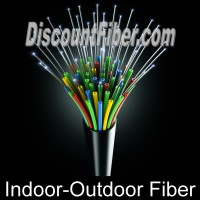“Singlemode 9/125” Indoor-Outdoor Fiber Cable
“Multimode 62.5” Indoor-Outdoor Fiber Cable
“Multimode 50/125 (OM2, OM3)” Indoor-Outdoor Fiber Cable
Indoor-Outdoor Fiber Optic Cable (9/125 8.3 SM, MM 62.5, MM 50/125-OM2/OM3)
With Fiber Optic Cable replacing the old technology of copper cables as an effective mode for transmitting communication signals, more and more organizations are now opting to install Indoor-Outdoor Fiber Cables to build a strong and effective networking infrastructure. Simply put, applications requiring Fiber Optic Cable with either single mode or multimode fiber optic installations in areas such as data centers, office buildings and industrial plants should opt for Indoor-Outdoor Fiber Cables to meet their networking and connectivity requirements.
Indoor-Outdoor Fiber Cables are described in many ways:
1. Indoor-Outdoor fiber cable Interlocking Armored
2. Indoor-Outdoor Bulk Fiber Optic Cable (indoor/outdoor)
3. Hybrid Indoor-Outdoor fiber optic cable
4. In/out Fiber Optic Cable
5. I/O Fiber Optic Cable
6. Singlemode Indoor-Outdoor Fiber Optic Cable
7. Multimode Indoor-Outdoor Fiber Optic Cable
8. Loose tube Indoor-Outdoor fiber cables Singlemode-Multimode
9. Tight-buffered Indoor-Outdoor Fiber optic cable
Indoor-Outdoor Fiber is suited for many applications such as premises cabling, campus environment cabling, premises distribution, and outside plant to provide for the growing needs of corporate-networking by providing higher internet speeds. Indoor-Outdoor Fiber Cable and Hybrid I/O Indoor-Outdoor Fiber offer many advantages over OSP Outside Plant or just plain indoor fiber optic cable. These cables are excellent for an easy cable transition from outdoors to indoors. Today, many companies opt for Indoor-Outdoor Fiber Optic Cable for inter-building LAN systems utilized for voice & data, fiber optic Cabling Infrastructure, OEM Optical Fibers, audio, video, telephony, data signal, FTTX distribution networks, CABLE tray, Enterprise, Campus, eABF, Network, Backbone and Structured Cabling. With the current shortages in plain OSP Outside Plant cables, many customers are considering Indoor/Outdoor Fiber Cable.
I/O Fiber Optic Cable is designed for applications where cable network installations include external pathways that transition into intra-building backbones, campus buildings and inter-building locations without the costly transitioning from OSP Outside Plant (outdoor) fiber to Indoor fiber optic cable. For example, Indoor-Outdoor Fiber can be installed from (building A’s) telecommunications room, linking to (building B’s) telecommunications room, via an exterior path, without having to terminate the fiber cables as it enters the building, as would be necessary with plain OSP Outside Plant Fiber Optic Cable as it transitions to Indoor Fiber Optic Cable.
Indoor-Outdoor Fiber is available in MM multimode 50/125, 62.5, OM1, OM2, OM3 and SM singlemode single mode 8.3/125 and 9/125 and OS1. It includes the following types of cable configurations such as: I/O Tight Buffer Cable M62, Buffered 900um, distribution construction, loose-tube, LT Optical, Breakout, Non-Armored Dielectric, Riser Rated, Plenum Rated, OFNP OFN OFNR, gel filled, all-dry, dry block, Bend-Tolerant, Light Duty Indoor/Outdoor 5138 Series Fiber, 550 Indoor/outdoor, Optical Cable HC-Series High Density, Telcordia GR-490, LSZH rated NEC/CEC OFNR/OFN FT.4, Loose Tube Outdoor, interlocking armored available in 6 Strand, 12 Strand, 24 Strand, 36 Strand, 48 Strand, 72 Strand, 96 Strand, 144 Strand and 288 Strand, DX072DSLX9KR and DX012DSLX9KR.
Indoor-Outdoor Fiber Cable is used for installing various data communication applications like FTTx. FTTx consists of a variety of fiber optics access infrastructures, which can includes FTTH (Fiber to the Home), FTTC (Fiber to the Curb) and others such as FTTD (Fiber to the Desk), FTTP (Fiber to the Premise) and FTTN (Fiber to the Node). When installing FTTH cables, it revolves around covering the entire distance between the building and the exchange. FTTH is capable of delivering data at greater speeds as compared to FTTC.
When utilizing plenum Indoor/Outdoor cables, they can be installed in plenum spaces without the use of costly plenum innerduct. When using this fiber in a burial application, this cable must be placed in a conduit or innerduct. For aerial installations, the Indoor-Outdoor Fiber Cable jacket is UV protected and will usually need to be lashed. Depending upon their needs, users can opt for lose tube Indoor-Outdoor Fiber Cable, ribbon Indoor-Outdoor Fiber or tight buffer Indoor-Outdoor Fiber Optic Cable. Each of these types of cable boasts a flexible design and the ability to be installed in many different environments. Versatility makes this cable very viable option when planning out your projects.
The tight buffered Singlemode Indoor-Outdoor Cable and Multimode Indoor-Outdoor Cable are 900μm, emulating the benefits of tight buffering that is used in Indoor fiber optic cables. This technology is incorporating the benefits of 900um Tight Buffered fibers which are generally found in the cables installed inside industrial plants and many other indoor applications. Loose Tube (LT) Indoor-Outdoor Fiber Cable is ideal for various applications of installation such as Tray based Fiber Management, Lashed Aerial and Duct/Conduit them same as it would be found in outside installations.
Discount Fiber stocks a selection of Indoor-Outdoor Fiber Cables in both Singlemode and Multimode. Please contact us with any questions you may have or to request a quote.



 (800) 783-4006
(800) 783-4006